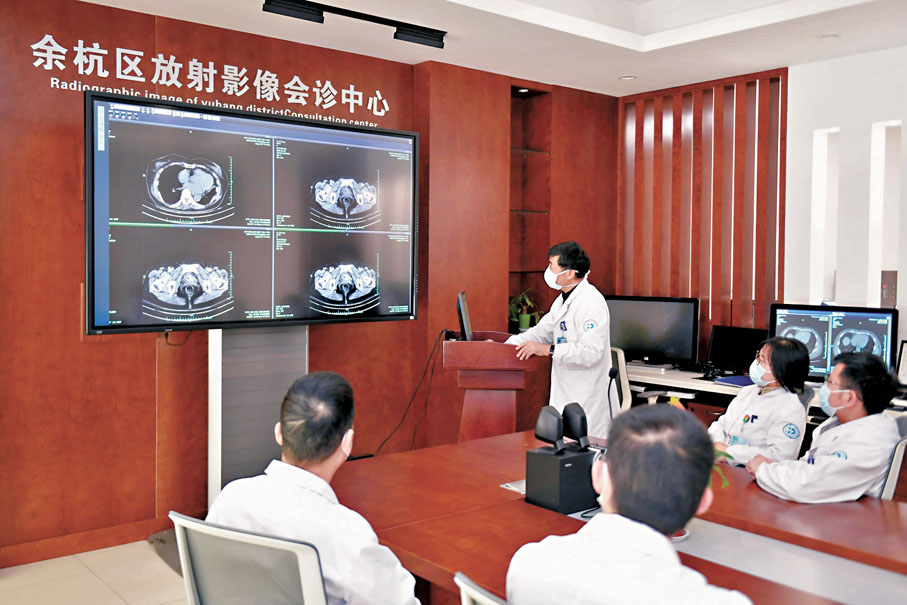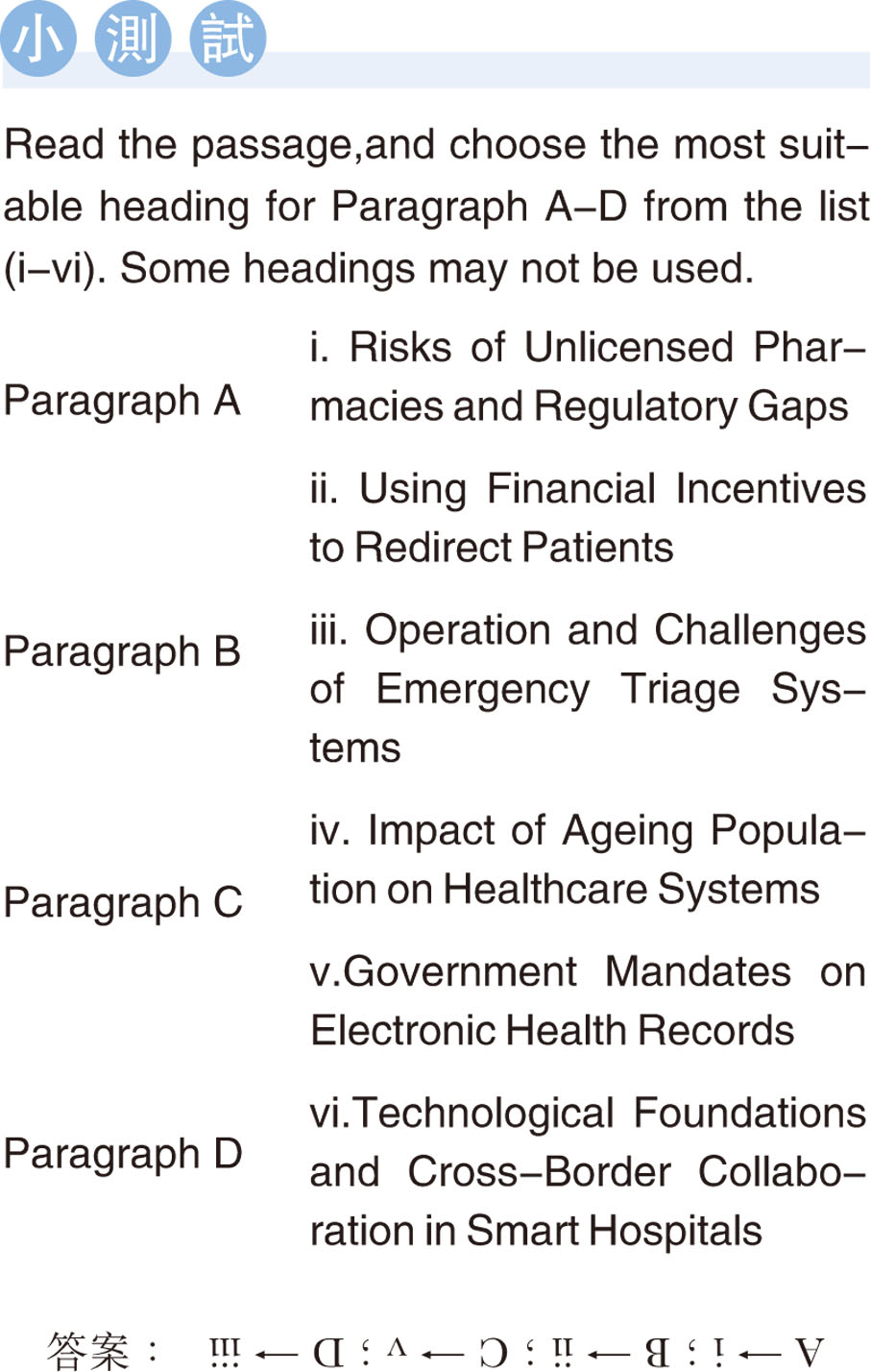【社評雙語道】建設智慧型醫院 解決睇病貴難題


【原文】摘錄自3月20日香港《文匯報》:隨着人口老齡化加劇,公營醫療系統的壓力不斷增大。在此背景下,公營醫療系統積極檢討公立醫院急症室收費實無可厚非。公立醫院急症室目前採取分流制度,將病人分為危殆、危急、緊急、次緊急以及非緊急五類。
然而,現實情況是,大量次緊急和非緊急病人湧入急症室,導致真正需要緊急治療的病人面臨漫長的輪候時間。醫管局指出,過去一年有近200萬人次向急症室求醫,其中逾半為次緊急個案,部分危急和緊急個案卻未能得到最佳治療。
為了解決這一問題,消息指醫管局有意將急症室收費實施兩級制,對危殆及危急病人繼續免費,同時提高緊急、次緊急和非緊急病人收費。這樣做旨在通過經濟手段引導病情較輕的病人轉向其他醫療服務,從而釋放急症室資源,讓真正急需救治的病人獲得及時治療。
調查發現,部分藥房職員充當山寨醫生,給市民亂開處方藥。這些藥房不僅缺乏專業的醫療人員,還違規出售管制藥物,給市民的健康帶來嚴重風險。
這種現象確實應該加強執法和堵塞法律漏洞來應對,但進一步深思,這種現象亦反映了香港基礎醫療服務收費高昂、市民睇病成本貴的問題。一般市民即使就常見的傷風感冒求診,都動輒要三四百元以上的診金,於是部分基層市民選擇自行去藥房「配藥」。
內地在醫療科技方面的發展為香港提供了有益的借鑒,智慧型醫院利用大數據、人工智能(AI)等先進技術,實現了醫療資源的優化配置和醫療服務的高效提供。
內地近年來在互聯網醫療領域取得了顯著進展,普通民眾患上一般常見病症,可以通過網絡問診與醫生線上溝通,然後直接購買處方藥物。這種做法不僅大大降低了市民治療常見疾病的成本,還有效緩解醫院的人流壓力。
這給予了香港醫療改革一個有益的啟示:必須善用最新的技術手段來提升醫療效率,從而達到降低患者治療成本的目的。
在具體的做法上,首先,香港可以借鑒內地的做法,建立互聯網醫療平台,讓市民能夠通過網絡問診與醫生線上溝通,讓醫生判斷能否直接處方藥物給患者。
其次,可利用大數據、AI等先進技術,推動智慧型醫院的建設,實現醫療資源的優化配置和醫療服務的高效提供,提高醫療系統的整體效率。
事實上,政府建議修訂「醫健通」的使用機制,賦權醫務衞生局局長可要求醫護必須將重要電子健康紀錄,例如病人敏感及藥物不良反應、化驗及放射報告等,存放至市民的醫健通戶口,又建議在符合指明條件下,認可個別境外的醫護提供者,跨境使用醫健通電子健康紀錄。這已經為互聯網醫療系統和市民使用跨境醫療服務構建了重要的數據庫基建。
期待在特區政府和公私營醫護的共同努力下,香港可以逐步解決醫療資源不足、市民睇病成本昂貴等問題,為市民提供更加優質、高效的醫療服務。
Building Smart Hospitals to Address Healthcare Access Challenges
【譯文】As the population continues to age, the pressure on the public healthcare system is intensifying. In this context, it is entirely reasonable for the public healthcare system to actively review the charges for Accident and Emergency (A&E) services in public hospitals. Currently, a triage system is implemented in A&E services at public hospitals, categorising patients into five levels: critical, emergency, urgent, semi-urgent, and non-urgent.
However, the reality is that a large number of semi-urgent and non-urgent patients have swarmed into A&E services, resulting in long waiting time for those in genuine need of urgent treatment. The Hospital Authority has noted that nearly two million people sought treatment at A&E services in the past year, of which more than half were semi-urgent cases, while some critical and emergency cases were not given optimal treatment.
Paragraph A. To address this issue, it is reported that the Hospital Authority is considering implementing a two-tier charging system for A&E services. Under this system, critical and emergency patients would continue to receive free treatment, while charges for urgent, semi-urgent, and non-urgent patients would be increased. The aim is to use financial means to encourage patients with less severe conditions to seek other healthcare services, thereby freeing up A&E resources for those in genuine need of urgent treatment.
Paragraph B. Investigations have revealed that some pharmacy staff are acting as quack doctors, irresponsibly dispensing prescription drugs to the public. These pharmacies not only lack professional medical personnel but also illegally sell controlled drugs, posing significant health risks to the public. This phenomenon should indeed be tackled by stepping up law enforcement and plugging the loopholes in the law. However, on further reflection, this phenomenon also reflects the problem of exorbitant charges for primary health care services in Hong Kong and the high costs for the public to see a doctor. Even for common ailments like a cold or flu, consultation fees can easily exceed three to four hundred dollars, prompting some grassroots people to opt for pharmacies on their own to have medicines dispensed.
Paragraph C. The development of medical technology in Mainland China offers valuable insights for Hong Kong. Smart hospitals in the mainland utilise advanced technologies such as big data and artificial intelligence (AI) to optimise the allocation of medical resources and deliver efficient healthcare services. In recent years, significant progress has been made in the field of internet healthcare in the mainland. The general public can consult doctors online for common illnesses and directly purchase prescription medications. This practice not only greatly reduces the cost of treating common diseases but also effectively relieves the pressure on hospitals in terms of patient flow. This has given Hong Kong's healthcare reform a useful revelation: the latest technological tools should be leveraged to enhance healthcare efficiency and reduce treatment costs for patients.
In terms of specific practices, first of all, Hong Kong can learn from the practice of the Mainland and establish an Internet healthcare platform, allowing the public to consult doctors online and receive prescriptions directly when appropriate. Secondly, advanced technologies such as big data and AI can be utilised to promote the development of smart hospitals, optimising the allocation of medical resources and delivering efficient healthcare services, thereby improving the overall efficiency of the healthcare system.
Paragraph D. In fact, the government has proposed revising the usage mechanism of the "eHealth" system, empowering the Secretary for Health to require healthcare providers to store important electronic health records, such as patient allergies and adverse drug reactions, laboratory and radiology reports, in citizens' eHealth accounts. It is also suggested that, under specified conditions, certain non-local healthcare providers be authorised to use eHealth electronic health records across borders. This has already laid a crucial data infrastructure for building an internet healthcare system and enabling citizens to access cross-border medical services. It is hoped that with the concerted efforts of the Government and the public and private healthcare sectors, Hong Kong can gradually resolve the problems of insufficient healthcare resources and the high cost of medical services for the public and provide the public with more high-quality and efficient healthcare services.● Tiffany
小測試
Read the passage,and choose the most suitable heading for Paragraph A-D from the list (i-vi). Some headings may not be used.
Paragraph A
i. Risks of Unlicensed Pharmacies and Regulatory Gaps
ii. Using Financial Incentives to Redirect Patients
Paragraph B
iii. Operation and Challenges of Emergency Triage Systems
Paragraph C
iv. Impact of Ageing Population on Healthcare Systems
v.Government Mandates on Electronic Health Records
Paragraph D
vi.Technological Foundations and Cross-Border Collaboration in Smart Hospitals
答案:A → i;B → ii;C → v;D → iii
